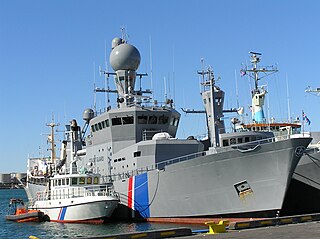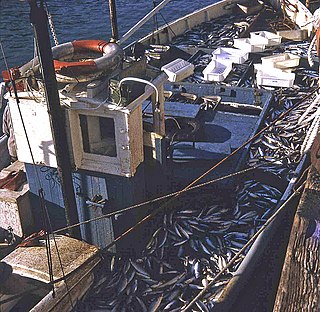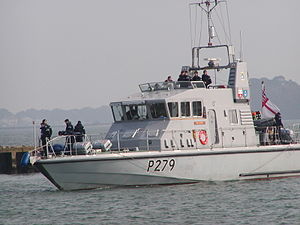The Cod Wars were a series of 20th-century confrontations between the United Kingdom and Iceland about fishing rights in the North Atlantic. Each of the disputes ended with an Icelandic victory.

The Turbot War was an international fishing dispute and bloodless conflict between Canada and Spain and their respective supporters.

Condor Ferries is an operator of passenger and freight ferry services between the United Kingdom, Guernsey, Jersey and France.

ICGV Týr is an Ægir-class offshore patrol vessel and the former flagship of the Icelandic Coast Guard. The ship was built by Dannebrog Værft in Denmark in 1974–1975 and entered service in 1975. Týr was for a time the second largest ship in the Icelandic Coast Guard and participated in the Third Cod War. The ship conducted patrols, search and rescue, fishery inspections, general law enforcement and counter-terrorism operations in the Icelandic exclusive economic zone and the waters of the surrounding territories, such as Greenland and Jan Mayen. Týr was decommissioned in 2021 and sold in 2022.

ICGV Ægir is a former offshore patrol vessel of the Icelandic Coast Guard. Built by Aalborg Værft, in Denmark, she is the lead ship of the Ægir class and has one sister ship of an improved design, ICGV Týr. The ship entered service in 1968 and participated in the two last Cod Wars against the United Kingdom. Ægir primarily conducted patrols, search and rescue, fishery inspections, general law enforcement and counter-terrorism operations in the Icelandic exclusive economic zone. In 2020, the patrol vessel was taken out of service and sold two years later.

HMS Brocklesby is a Hunt-class mine countermeasures vessel of the British Royal Navy, her primary purpose is to find and neutralise sea mines using a combination of; Sonar, Mine Clearance Divers and the Seafox remotely operated vehicle (ROV). The class are the largest warships of glass-reinforced plastic (GRP) construction, which gives the vessels a low magnetic signature. In addition to her mine countermeasures activities, Brocklesby acts as an offshore patrol vessel, undertaking coastal patrol and fisheries protection duties.

HMS Blazer is an Archer-class patrol vessel of the Royal Navy. She was built by Vosper Thornycroft. She is 20.8 metres long and 5.8 metres wide and powered by two Rolls-Royce diesel engines. The ship is based at HMNB Devonport, the shore base in Plymouth and was commissioned in 1988.

The fishing industry in Scotland comprises a significant proportion of the United Kingdom fishing industry. A recent inquiry by the Royal Society of Edinburgh found fishing to be of much greater social, economic and cultural importance to Scotland than it is relative to the rest of the UK. Scotland has just 8.4 per cent of the UK population but lands at its ports over 60 per cent of the total catch in the UK.

Naval trawlers are vessels built along the lines of a fishing trawler but fitted out for naval purposes; they were widely used during the First and Second World Wars. Some, known in the Royal Navy as "Admiralty trawlers", were purpose-built to naval specifications; others were adapted from civilian use. Fishing trawlers were particularly suited for many naval requirements because they were robust vessels designed to work heavy trawls in all types of weather, and had large clear working decks. A minesweeper could be created by replacing the trawl with a mine sweep. Adding depth charge racks on the deck, ASDIC sonar below, and a 3-inch (76 mm) or 4-inch (102 mm) gun in the bow equipped the trawler for anti-submarine duties.

BNS Shaheed Ruhul Amin was an Island-class offshore patrol vessel of the Bangladesh Navy used as a training ship. She was built and served as a Royal Navy Island-class patrol vessel HMS Jersey (P295) from 1977 to 1993.
HMS Orkney was an Island-class patrol vessel of the Royal Navy. In 2000 she became TTS Nelson of the Trinidad and Tobago Coast Guard. In 2016, the vessel was sold for scrap.

The action of 15 August 1917 was a naval engagement which occurred during the First World War. The action was fought between a German U-boat and two naval trawlers, Nelson and Ethel & Millie, in the North Sea.

The Overseas Patrol Squadron is a front-line squadron of the Royal Navy with responsibility for patrolling the UK's Extended Fisheries Zone, both at home and around British Overseas Territories. The squadron, with headquarters at HMNB Portsmouth, is equipped with eight of the River-class patrol vessels.
The 2010 Eocheong boat collision incident occurred on December 18, 2010 off Eocheong Island in the Yellow Sea. It involved the Republic of Korea Coast Guard (ROK) and fishermen from the People's Republic of China. About 50 Chinese trawlers were illegally fishing about 120 kilometers off the island of Eocheong. A Republic of Korea Coast Guard ship shot the fishermen with water cannons to move them back. When the coast guardsmen began boarding the ship to detain the fishermen, the trawler intentionally collided with one of the Korean coastguard patrol boats.

The English Channel scallop fishing dispute, also called the Great Scallop War or guerre de la coquille, occurred on 10 October 2012 or 8 October 2012, between British and French fishermen in the Channel 24 kilometres (15 mi) off the coast of Le Havre, France. The dispute arose because of a difference in fishing restrictions between the two countries. British scallop fishers are allowed to fish for scallops year round, whilst French scallop fishers are not permitted to fish between 15 May and 1 October each year. Other confrontations took place in the same area on 28 August 2018 and 13 October 2020.

The Bailiwick of Guernsey is a British Crown dependency in the English Channel off the coast of Normandy. As a bailiwick, Guernsey embraces not only all ten parishes on the island of Guernsey, but also the islands of Alderney and Sark – each with their own parliament – and the smaller islands of Herm, Jethou and Lihou. Although its defence is the responsibility of the United Kingdom, the Bailiwick is not part of the United Kingdom, but, as its description suggests, a possession of the Crown. Consequently, though it lies within the Common Travel Area, it was never part of the European Union.

Fish for finance is a possible trade-off that has been considered by both sides in the trade negotiations between the United Kingdom and the European Union (EU) over their future relationship following Brexit in January 2020. The Brexit withdrawal agreement between the two parties called for an agreement on fisheries to be concluded by June 2020, followed by an agreement on financial services at the end of July, deadlines which were both missed. Both were expected to be part of the final EU–UK trade agreement reached by the end of 2020, the end of the Brexit transition period. The final agreement had some broad outlines for a future fishing deal, primarily gradual EU concessions of fishing quota in UK waters, but was largely silent on finance.

The Spanish fishing trawler Sonia sank off the Cornish coast of England on 20 October 1984. On 19 October, in Irish territorial waters off the coast of County Wexford, the Sonia had been spotted by the Irish Naval Service patrol vessel Aisling and was suspected to be fishing illegally. The Sonia was ordered to halt and prepare to receive a boarding party, but did not comply.

In 2021, a dispute erupted between French fishermen and the Government of Jersey about the licensing of French fishing boats to fish in Jersey's territorial waters. Jersey is a British Crown Dependency, and despite not being part of the United Kingdom, the licensing of European Union fishing boats to fish in Jersey's territorial waters has changed after the UK exit from the EU. On 6 May 2021, French fishermen held a protest in the waters off Jersey's main harbour. The UK is responsible for the defence of the Channel Islands and sent two patrol boats to Jersey in response to the fishermen's threats to blockade it. French politicians suggested that Jersey's electricity supply fed by undersea cables from France could be cut off in retaliation for Jersey placing limitations on the extent to which French boats can fish in the island's waters.

The Persée was a Redoutable-class submarine in the navies of the French Third Republic and Vichy France. Belonging to the M6 series, it was launched in 1931. The vessel was damaged by an explosion while undergoing sea trials off the coast of France, killing two aboard and wounding several others. Based at Brest at the onset of the Second World War, Persée joined in the search for the German merchant fleet still at sea. The vessel joined the Vichy France Navy and transferred first to Casablanca then Dakar. Persée was attacked at Dakar where the submarine was torpedoed on the surface by a British ship. The vessel was set afire and sank, with the entirety of the crew rescued save one.


















